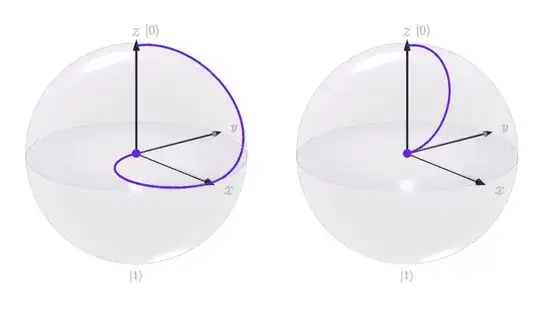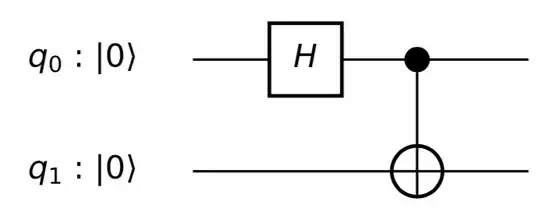Let $(x,y,z)$ be a point in the unit ball with $x^2+y^2+z^2 \leq 1$.
The state associated with this point is
\begin{eqnarray*}
\rho &=& \frac{1}{2} (I_2 + x \sigma_x + y \sigma_y + z \sigma_z)\\
&=& \frac{1}{2} \begin{pmatrix}
1+z&x-iy\\
x+iy&1-z\\
\end{pmatrix}
\end{eqnarray*}
This is just a convenient way to parameterize all $2\times 2$ density matrices. This doesn't work as nicely for qudits with $d \neq 2$. But since we are talking $d=2$, we might as well use this nice parameterization.
In particular let $(x,y,z)=(0,0,0)$, the associated $\rho$ is
\begin{eqnarray*}
\rho &=& \frac{1}{2} \begin{pmatrix}
1+0&0-i0\\
0+i0&1-0\\
\end{pmatrix}\\
&=& \begin{pmatrix}
\frac{1}{2}&0\\
0&\frac{1}{2}
\end{pmatrix}
\end{eqnarray*}
This is the maximally mixed state.
What is being shown is the state for only 1 qubit. This is the result after taking a partial trace over the other qubit.
So if looking at the first one $q_0$. It starts off in the state
\begin{eqnarray*}
\rho &=& | 0 \rangle \langle 0 |\\
\end{eqnarray*}
which corresponds to $(x,y,z)=(0,0,1)$
Then it goes to
\begin{eqnarray*}
\rho &=& H | 0 \rangle \langle 0 | H\\
\end{eqnarray*}
But after the CNOT it is
\begin{eqnarray*}
\rho &=& \text{Tr}_2 (\operatorname{CNOT}_{12} H | 0 0 \rangle \langle 00 | H \operatorname{CNOT}_{12}) \\
\end{eqnarray*}
which ends up being the maximally mixed state corresponding to $(x,y,z)=(0,0,0)$
Edit: As stated above "This is just a convenient way to parameterize all $2\times 2$ density matrices. This doesn't work as nicely for qudits with $d \neq 2$. But since we are talking $d=2$, we might as well use this nice parameterization." So even if density matrices still make you queasy, don't think of the center of a sphere as being something particularly meaningful. It is just a convenient way to draw all states and in this case the center happens to line up with the maximally mixed state. So no it is not something fundamental. It doesn't generalize to other $d$ or more qubits. Don't take this particular parameterization too seriously, it just allows us to plot the state in a way to quickly convey the information visually.

